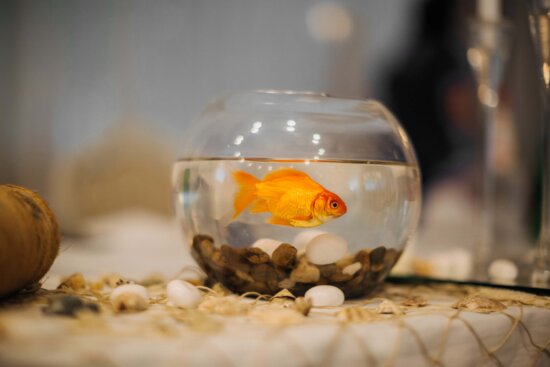You probably had a name for yours. Maybe it was “Fred” or the unironic “Goldie.” You took the car ride home to make plans: where Fred would live, how you would share all your meals together, and never spend a second apart. If you heretofore had not believed in destiny, Fred was a good reason to think otherwise. The serendipity of your Ping Pong ball landing in his glass bowl was enough to convert the staunchest of disbelievers. It was fate.
But like that day at the carnival, nothing good lasts forever. Within a week, Fred was belly up and flushed away.
In her 2018 book Goldfish, science historian Anna Marrie Roos writes about the socio-cultural, scientific, and artistic history of the humble goldfish. Interestingly enough, this third-most popular household pet didn’t start out as gold at all. In fact, it was a rare mutation amongst carp that protected the gold mutants from their fate in the kitchens of Imperial China. Goldfish emerged as a species cultivated and protected for Buddhist offerings in mercy ponds, too beautiful to be eaten.
After domestication in China over a thousand years ago, goldfish were brought to Japan and then Europe as household pets and living fixtures in fountains and aquatic displays. By the time goldfish entered the United States, Roos writes, they were far from their beginning as religious offerings. In what could be considered the first recorded instance of goldfish as prizes, the U.S. Commission of Fish and Fisheries once offered a goldfish to every Baltimore resident who wrote their congressional representatives. From 1884 to 1894, the U.S. government gave 20,000 goldfish away each year.
By the 1920s, department stores such as Woolworth, Grant, and McLellan had opened pet departments within their stores. Goldfish were becoming an attractive household pet, so popular that fisheries could only breed enough fish to meet demand for half the year. According to Roos, the hatcheries, such as the still operational Grassyfork Fishery in Indiana, drew tourists from across the country.
America’s treatment of goldfish reached a new level of absurdity in 1939, when a Harvard freshman named Lothrop Withington, Jr. swallowed a live fish on a dare. Later, Withington remembered how “the scales caught a bit on my throat as it went down.” The dare began a fad, so prolific Life magazine devoted pages to the fish swallowing craze that swept the nation. In March of 1939, MIT’s daily newspaper, The Tech, ran a front page story about the class of ‘42 student who was crowned champion of the Intercollegiate Goldfish Swallowing after devouring 37 living goldfish.
Fortunately, animal rights activists and politicians are seeking justice for the humble goldfish. Senator Suzy Glowiak Hilton, for example, recently introduced Bill 2472 to the Illinois General Assembly which would include goldfish into a pre-existing law that prohibits the use of live animals as prizes. If passed, Illinois would join states such as Iowa, South Carolina, Vermont and Massachusetts in protecting goldfish from fairgrounds and plastic bags. The bill, though, has yet to pass.
In the meantime, goldfish in many states, including my hometown of Ohio, are still subject to carnival cruelty, a fate that should strike us as tragic. Goldfish, after all, can feel pain. In their credo, the nonprofit organization Fish Can Feel reminds us that “The decision to have a companion animal is a serious responsibility…It should not be based on how well you can toss a ping pong ball into a bowl. Goldfish are living, feeling creatures, just like any other animal….The lack of concern with which goldfish are given away at fairs and carnivals conveys a wanton disrespect for their lives, and an indifference to their suffering.”
It’s possible we, including myself, are not moved to grave concern or action because any goldfish we’ve ever known was engineered to be small and golden, as disposable as a penny. In many ways, it was the accidental beauty of the goldfish that foreshadowed its destiny we have perpetuated through hatchery and treatment. In fact, a goldfish can grow to be five pounds in the wild, but as National Geographic notes, is “constrained by the size of its tank.”
The average human attention span is about eight seconds, shorter than a goldfish’s nine. It seems unfair that we, who can become distracted more easily than our animal counterparts, are endowed with the ability to dictate their lives, to cause their pain, and lose interest even before they’re out of our sight.

